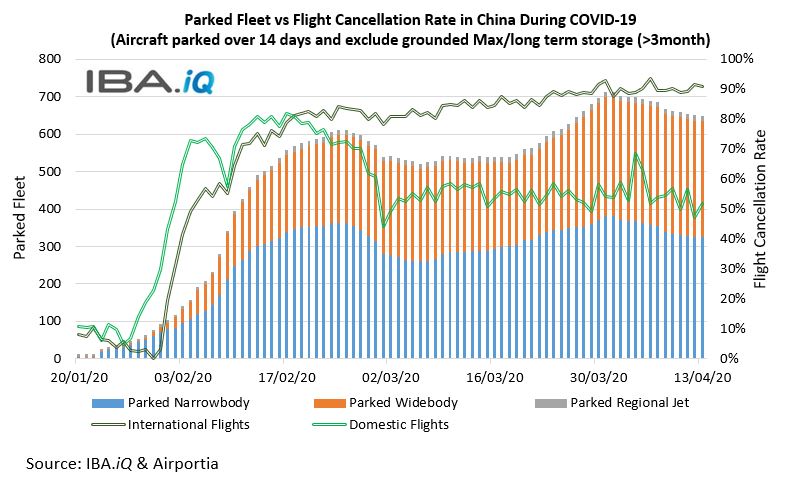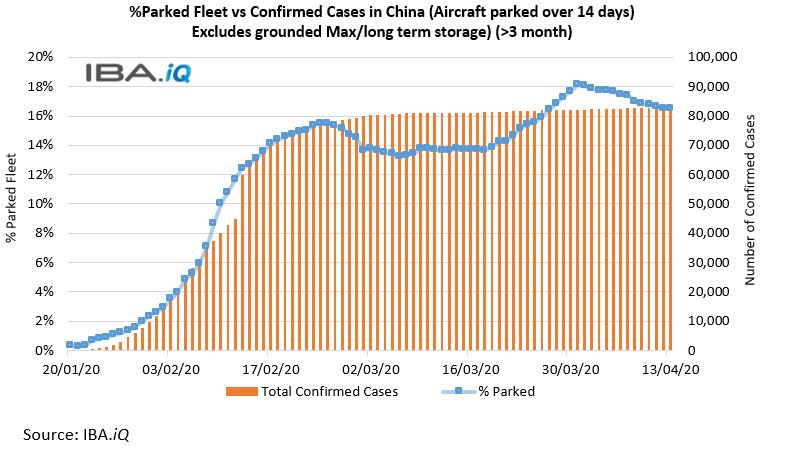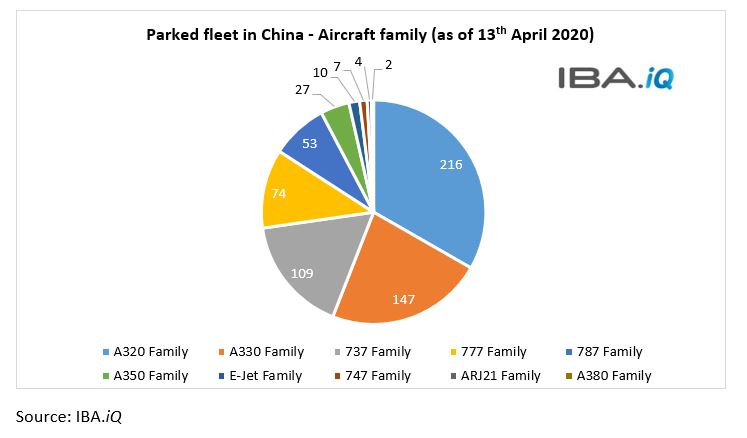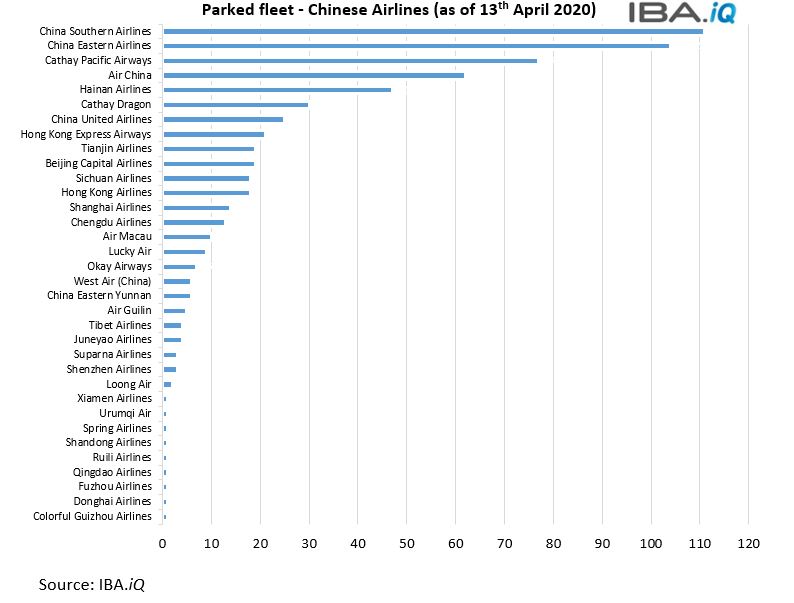24/04/2020
According to the data published by the World Health Organisation, the number of total confirmed COVID-19 cases reached over 1 million as of 4th April 2020, which has subsequently doubled to over 2 million in just two weeks. While the United States and many countries in Europe have seen a record number of confirmed cases and deaths, the condition in China, the original epicentre, has significantly improved and stabilised. COVID-19 has placed the entire community in a totally unprecedented territory, and its effects on the economy, lifestyle and culture will be long lasting. Despite the fact that the final statistics are yet to be concluded, the influence on the aviation market will be detrimental and profound.
With the advent of the Coronavirus outbreak in January 2020, the airlines in China faced a combined challenge of the massive cut in traffic demand and the surge in its parked fleet. As the situation ameliorated, some of the grounded aircraft have returned to service since early March. IBA's award-winning team of analysts have studied the evolution of the parked fleet in China (including Hong Kong and Macau) since Mid-January 2020, and a chart which illustrates the trend of the parked fleet in different aircraft classes, is produced and inserted below.
We define parked aircraft as being grounded for at least 14 days, in order to differentiate those aircraft undergoing light maintenance checks. In addition, we have excluded the grounded Boeing Max fleet and any other aircraft which have been stored beyond three months, for the purpose of purely concentrating on the influence of COVID-19.

Based on the data generated by IBA.iQ, the parked fleet curve reached an initial peak on 24th February with a total of 611 parked aircraft, which accounts for over 15% of the entire in-serviced fleet in China. If this number did not concern you, we could compare this with the percentage of average parked fleet in China as of 2019, which is roughly 0.6%. Although this figure has declined since then, the total parked has remained buoyant, especially for widebody aircraft, which was more severely impacted in comparison to the narrowbody aircraft. After declining over two weeks, the number of parked aircraft started to climb again, with both the narrowbody and widebody arriving at higher peak towards the end of March, with 713 parked aircraft.
A second wave was not expected as the number of the confirmed cases in China stabilized since early March. However, the second wave could be explained by the flight cancellation data provided from Airportia Flight Tracker, which indicated that the international cancellation rate in China continued to climb and reached above 90% since early April. At the same time, some of the domestic flights have resumed since early March and the cancellation rate has fallen, but still remains over 50%.
The Coronavirus outbreak initiated in China at the end of January 2020 when Wuhan, the original epidemic centre declared the lockdown, and as a result, there was a dramatic decrease in the number of the flights due to travel restrictions. Within roughly one week, both international and domestic flights saw their cancellation rates surge above 80%. Despite the fact that the lockdown in Wuhan has been officially ended on 8th April, both international and domestic flight cancellation rates remain high.
The skyrocketing in the international flight cancellation rate in China has been directly contributed by the huge numbers of international flight suspension elsewhere globally. Therefore, the number of the parked aircraft kept increasing even though the confirmed cases in China has flattened, which is illustrated in the chart below. In addition, the effect of COVID-19 on parked widebodies will be more likely to persist than the narrowbody due to the fact that most of the international routes are operated by twin-aisles.

By observing the chart above, the fall in the parked fleet during early March could also be reflected by the change in the number of the confirmed cases in China. As the cumulative COVID-19 curve has stabilized since early March, the parked fleet declined temporarily, especially on the narrowbodies which are mostly operated on the domestic routes in China. It was expected that passenger numbers would largely recover and aircraft would return to service once the lockdown was dismissed in China. However, the bell-shaped curve was not realized as the number of confirmed cases surged elsewhere as well as the recent increase of the imported cases and asymptomatic infection in some parts of China. Nevertheless, a combined sign of levelling-off and resurgence in the Chinese active fleet and a nearly 30% drop in domestic flight cancellations gives hope to other countries who are currently fighting against COVID-19 and those whose aviation industries are suffering.

With respect to the parked fleet in China, the Airbus A320 family took up a third of the entire parked fleet on 13th of April, followed by the Boeing 737 family, which represented 109 out of 649 total parked aircraft. Although the in-service widebodies only represented 16% of the entire Chinese fleet, the parked widebodies accounted for around 48% of the total parked fleet as of 13th April.
Within the widebody types, the Airbus A330 family occupied more parked aircraft than the Boeing 737 family, with China Eastern (35), China Southern (27) and Hainan Airline (19) topping the board, followed by another 10 airlines parking the remaining 66 A330s as of 13th April. Cathay Pacific Airways grounded 49 out of its 74 Boeing 777 family aircraft, which consisted of 35 B777-300ER and 14 B777-300 aircraft. While the "Big Three Carriers" also had their B777 fleets parked during the epidemic, as all of them were the Boeing 777-300ER variant, with China Southern (10), Air China (8) and China Eastern (7). Moreover, there were 53 Boeing 787 family aircraft being parked at the same time, which was a combined fleet of B787-9 (40) and B787-8 (13) models. Both China Southern (nine 787-9 and nine 787-8) and Hainan Airlines (13 787-9 and four 787-8) had both the models parked in their fleets, followed by four other operators having 18 B787 models grounded. For the Airbus extra-large widebody sector, Cathay Pacific had 15 Airbus A350s parked; China Southern parked four out of its 13 A350-900s, and it also parked its two Airbus A380-800s. In terms of the parked regional jets, China Southern (5) and Tianjing Airlines (3) have decided to park their E190 jets, while Chengdu Airlines disclosed four ARJ21 aircraft parked.

The COVID-19 pandemic has invaded every corner of the world and placed over four billion people under quarantine. On 9th March, Italy became the first country in Europe imposed a national lockdown in response to the growing pandemic of COVID-19, followed by many other European neighbours in the next two weeks. Hence, the COVID-19 status in China is roughly two months ahead of those in Europe and North America since Wuhan, the first lockdown city, announced its quarantine on 23rd January. When the European countries started to ease their lockdown measures in May/June, the recovery in the traffic demand for these countries is in limbo by given the fact that the number of the parked fleet and flight cancellation rates have remained high in China even after the lockdown was lifted. This could essentially affect the policy making on the OEM's supply side and potentially lead to a turbulence in the secondary market.
The early signs we have seen from China suggest a slow recovery in aircraft utilisation once restrictions are lifted. With the impact of COVID-19 in China reported to be 2-3 months ahead of other countries, IBA forecast that aircraft groundings in other regions will continue through the second quarter of 2020 (April - June).
If you have any further questions, comments or feedback please contact Jie Zhou
The data used within this article is from IBA's leading aviation intelligence platform, InsightIQ.
Please contact us via the link below for a demonstration.
Related content